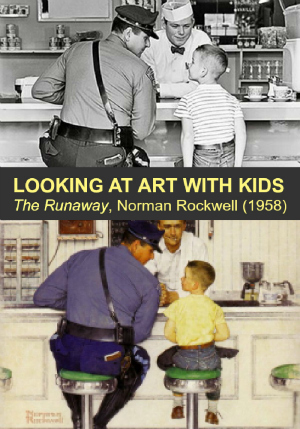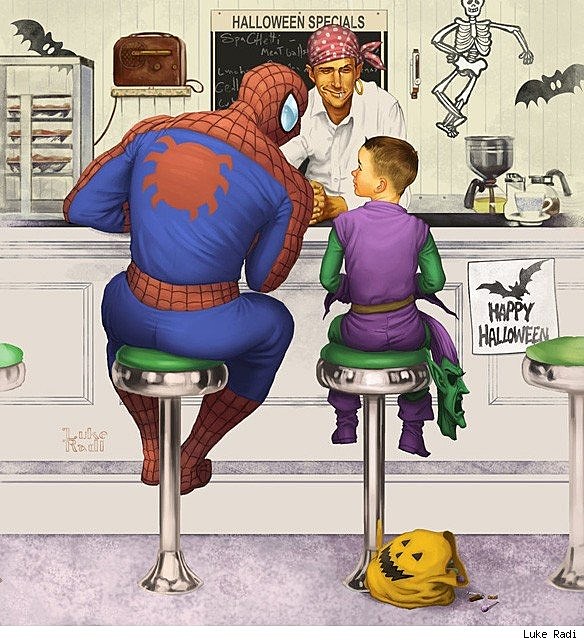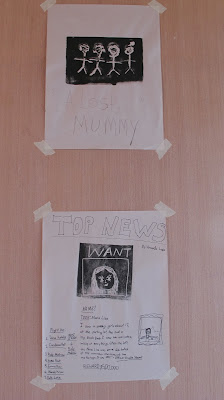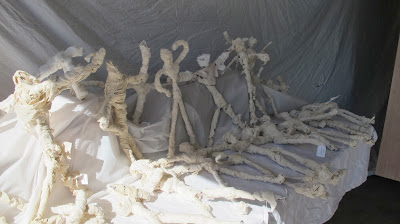We don't all have to sing in the choir, but we can have fun singing along to the radio. I believe we all have an artist inside us. This blog is to help you find yours or at least help you keep your children from losing theirs. Having the right tools and knowing a few tricks helps, but most important is to lose the fear. Art is a way to have fun- it's okay to sing out of tune.
2014 changes
I made a some minor changes to the winter and spring class dates for the Saturday classes. I also added a spring class. Well, more like split one into two. Hopefully it doesn't cause anyone any trouble, but check and let me know. Thanks!
Art: Stolen, Escaped, Recovered- extras
Here's a photo of my garage set up for the show. I hang sheets, a huge bolt of bleached muslin I bought at JoAnn's with a 50% off coupon years ago clipped to a clothesline on the sides to hide all of our tools, toys, and stuff. The boards are about an 1/8" thick wood I bought at a hardware store and then nail to the rafters of the garage. It works well because I can hang art on both sides of the boards. I also hang art on the back wall of my garage and that section is lit with Christmas lights. This time I also needed a section that is black so I could have a dark corner to use the black light flashlight. For that I hung black landscape plastic. I tried to hang it across part of the front too, but the wind was blowing too hard so my son ended up holding it up on that side when people wanted to use the black light.
I also had my sons set up a red laser obstacle course out of red yarn. I think the kids had fun with that.
Also, here's a video my sister and her kids made inspired by our theme:
Escape Artist
Love it, and thanks, Melissa!
I also had my sons set up a red laser obstacle course out of red yarn. I think the kids had fun with that.
Also, here's a video my sister and her kids made inspired by our theme:
Escape Artist
Love it, and thanks, Melissa!
Art: Stolen, Escaped, Recovered- Printmaking
This lesson focused on the escaped and recovered aspects of our theme. We made "want ads" or "lost" posters for a missing art piece. We carved a block, printed it on newsprint, and then wrote the rest of our ad underneath on our best print. (The preschool class stuck with just an initial and had parent help- child wrote the letter, parent carved, printed together).
Supplies:
ink
ink plate (I use a piece of plexi-glass)
wipes (for wiping ink off hands)
paper towels
bucket of water
roller
baren
newsprint
black pens or markers
carving block
carving tools
When carving the most important thing to keep in mind is that your image will appear the reverse. So if you write anything, write it backward so that it will print forward.
Draw on your block and then begin carving. I find it easiest to hold the tool in my hand like I would and ice cream scoop and then glide it across the block.
Once you have finished carving put about a tablespoon size blob on the ink plate. Roll the roller in the ink and on the plate until you have an even coating of ink on the roller. Roll the roller across your block until it is evenly covered in ink. Place your piece of paper on your block. Use the baren to rub over the paper making sure the ink is evenly pressed on the block. Gently lift away the paper and you have your print! I like to do another one or two prints with that block to clean it off then clean the block with a damp paper towel. Since I did this outside I had an ice cream bucket of water and had the kids get a paper towel, dip it in the bucket, squeeze it out, and then use it to wipe off their blocks. Make as many prints as you want or have time for. I use Blick water soluble ink so it rinses off and cleans up quite easily.
Kids are so creative. I love it :-)
Art: Stolen, Escaped, Recovered- Mummies
If anything is going to escape from a museum, I'm betting it's going to be the mummies.
Here's a fun mummy music video (sorry I couldn't get it to embed with a picture).
Here's another great link I found about mummies and ancient Egypt from The British Museum.
Bodies were mummified with natron. According to wikipedia natron is sodium carbonate decahydrate or a type of soda ash, 17% sodium bicarbonate (baking soda), and small amounts of sodium chloride and sodium sulfate. We aren't actually mummifying anything though. Just wrapping.
Supplies: wire, needle nose pliers, newsprint strips, masking tape, glue, water, fabric strips, gauze (optional).
I took pictures of each step, but I can't seem to find them. Here's a link to the tutorial I used to make the wire body frame for our mummies. After making the wire frame we wadded some newsprint into a ball and stuffed it in the loop that is the head and then taped around it so it would stay. We did the same thing for a back and chest. Then we took strips of newsprint and wrapped them around the body, taping where needed to hold the paper to the wire. Pose your wire and paper man the way you would like.
For the younger class my family and I made the wire and taped mummies so all that would be left is the fabric and glue. I also had my kids on hand to help anyone in the longer class (It is a little hard and most kids needed help). After you have your wire and paper man ready you will need to get a bowl of glue mixed with a little water and stirred together. Dip your fabric strips in the bowl- then hold the strip above the bowl with one hand and slide the other hand from the top to the bottom to get rid of extra glue. Wrap this strip around the wire and paper body. Continue this process until you are happy with your mummy wrapping. Once you have completely covered your mummy you can add a layer of gauze to make it more mummy like. Not all kids are up to this tactile experience. It is messy. Some kids didn't mind, some enjoyed it, some tried it and left to play and came back, some tried it and left to play and didn't try again, and others flat out refused to touch the glue. I did make everyone at least try it before running to my swing set. ;-)
Before class, with my kids, we tried using Paverpol. Paverpol sounded way awesome because it is waterproof so you could use it for outdoor sculptures and this seemed like a good excuse to experiment. It is great, but we went through a lot of it just to do our 6 and it's expensive. I was planning on the preschool group using Elmer's glue mixed with a little water since it is washable and noticed it did a great job so I used the Elmer's for all my classes. I tried using gauze strips I got from the pharmacy, but they are pretty thin and I found that covering the mummy first with muslin torn into strips and then adding gauze on top of that was a better look.
Art: Stolen, Escaped, Recovered- Drawing the Mona Lisa


Learning about the Mona Lisa fits our theme very well. She was stolen, she was hidden, and she has been returned. She's had quite an exciting life for a painting.
For this class we thought about where we would take the Mona Lisa to get out of the museum and have a little adventure for the day. This is an idea I saw on Pinterest and fell in love with. I can't take credit for it. I did change it up a bit though and came up with my own lesson plan. I had the students stick with charcoal, conte crayon, and/or brown chalks. For the preschool class we kept it pretty simple. I showed them a poster of the Mona Lisa and told them she is famous for her "smile". Do you think she is happy, sad, or just thinking? What do you think she is thinking about? Let's pretend that she is tired of hanging on the wall in the museum. Where would you take her to have fun? What do you like to do or what is your favorite place to go?

For the longer class we spent some time talking about Leonardo da Vinci's drawings and I shared a few pictures of those. we talked about proportion/measuring objects by comparing them to the other objects around them, and shading. We stuck with charcoal and brown chalks again to look like Leonardo's sketches. For these sketches we drew and shaded a stack of rocks. You can see in the above photo one child's stack of rocks and his drawing of him with Mona Lisa. (so cute!) We also compared Leonardo's work to artists of an earlier time period to see the difference and why he was considered such a great artist.


Also for the longer class we went into a little more detail of Mona Lisa's past. She is 77cmX53cm and currently lives in the Musee du Louvre. She was "born" about 1503-06. Mona means "madam" in Italian. In 1797 Mona Lisa was kidnapped as a prize during the French Revolution and taken to a new home at the Louvre. According to www.arthistoryguide.com Napolean had her hung in his bedroom for a little while before taking her to the Louvre. In 1911 a thief hid in a broom closet until the museum closed, stole Lisa, hid her in his jacket, and walked out the front door. The thief, Vincenzo Peruggia, was caught in 1913 when trying to sell Mona Lisa to the Uffizi Gallery in Italy. He felt Mona Lisa should be returned to her home country. During World War II Mona Lisa was removed from the Louvre and hidden to keep her safe from invading armies. There are a number of places mentioned online saying where she was hidden, but I don't know how credible those sources are. In 1956 Mona Lisa was vandalized. Someone threw acid at her and another time during the same year someone threw a rock at her. Now she is protected behind climate controlled bullet proof glass.
So, if you are used to this exciting life and have been stuck inside in the same spot for a few decades, would you be a little bored? Where would you take the Mona Lisa? Just for a day. Write your story.
 |
| (I love this- hey, come on, just hop in my mini-van) |
 |
| Mona Lisa has probably always dreamed of being in a marching band spinning a flag :-) |
Art: Stolen, Escaped, Recovered- Paintings
This lesson covered "stealing". Not necessarily how you might first think. We talked about stealing ideas and from other art. Everyone gets ideas from somewhere and it's the combination of those ideas in your mind that makes them your own. I used the example from Austin Kleon's book Steal Like An Artist, of the family tree analogy. You have a mom and dad each unique, but together they make you. You have a couple of ideas and when you put them together they make a new idea. For the younger class we "stole" Van Gogh's idea of painting a vase of sunflowers. We also looked at other artist's paintings of sunflowers. Painting sunflowers is not a unique idea, but each artist paints the same thing differently.
The older class was asked to choose two pieces of art to combine into one. When it came down to painting though, I think most of them changed their mind and just wanted to paint the sunflowers. Not a problem for me though, the results were great.
(I can't believe I didn't take more pictures! I had around 30 paintings...If anyone has some photos of more of our classes or at the art show please send them my way and I'll add them in)
In the older class we also talked about how to tell the real Rembrandt from the fake- something I found in a magazine while waiting at my teen's orthodontist appointment (link here)
and this Norman Rockwell painting (the image is a link to the website where I found it and great blog for young kids and art) and a spin off by Luke Radi titled Spider-Man (image is a link). We talked about what was similar and what was changed from the photograph to the painting to the next painting.


When I do a painting class I usually give the kids the following colors and have them mix to make the other colors they need:
Magenta
yellow
cerulean
burnt umber (brown)
white
black
sometimes I'll add:
yellow ochre (golden brown)
ultramarine blue
red
It's just personal preference. I think the cerulean makes a better range of greens and you can get the bright and light limes that are so much fun. Using just ultramarine blue that usually comes in kits and starter sets is usually frustrating for young painters because it has so much black in it and the greens are always dark. Just my opinion and observation- other people maybe would disagree.
 |
| When I asked my preschool class to go ahead and start painting the flowers one little girl did exactly what I said- so adorable! |
The older class was asked to choose two pieces of art to combine into one. When it came down to painting though, I think most of them changed their mind and just wanted to paint the sunflowers. Not a problem for me though, the results were great.
(I can't believe I didn't take more pictures! I had around 30 paintings...If anyone has some photos of more of our classes or at the art show please send them my way and I'll add them in)
In the older class we also talked about how to tell the real Rembrandt from the fake- something I found in a magazine while waiting at my teen's orthodontist appointment (link here)

and this Norman Rockwell painting (the image is a link to the website where I found it and great blog for young kids and art) and a spin off by Luke Radi titled Spider-Man (image is a link). We talked about what was similar and what was changed from the photograph to the painting to the next painting.


When I do a painting class I usually give the kids the following colors and have them mix to make the other colors they need:
Magenta
yellow
cerulean
burnt umber (brown)
white
black
sometimes I'll add:
yellow ochre (golden brown)
ultramarine blue
red
It's just personal preference. I think the cerulean makes a better range of greens and you can get the bright and light limes that are so much fun. Using just ultramarine blue that usually comes in kits and starter sets is usually frustrating for young painters because it has so much black in it and the greens are always dark. Just my opinion and observation- other people maybe would disagree.
Art: Stolen, Escaped, Recovered- Clues
If you are a detective what do you usually look for? Clues. This lesson's projects all have to do with clues. What are somethings you would look for at a crime scene? Fingerprints? Footprints?
One of our projects for this lesson involves making fingerprint and footprint jewelry.
We pinched a small piece of clay, rolled it in a ball, and pressed our finger in it or stepped on it, or found another object to leave a mark. Don't forget to poke a hole at the top big enough to thread a string for a necklace. We then set them on 3X5 cards labeled with each child's name and cut a piece of string the size each child wanted and set it on the card. I also used dot stickers with each name folded over the string to help keep everyone's straight. After class I spray painted the charms with copper or silver spray paint.
Warning- keeping everyone's straight when spray painting can be a bit tricky so make sure you have your system down- I first tried leaving them on the card, but of course the spray paint paints over the name. The clay is also very light weight, almost like paper, so sometimes the spray paint force blew the charms off of the card. I lined each up and made a list of the order and just did a few at a time inside a box so I could do my best to remember whose were whose. I still ended up with one no one claimed.
To display the jewelry I had clean 3X5 cards that I cut two short slits on one edge and at the end of those slits I hole punched a hole for the necklace string to rest. I threaded the string through the hole of the charms. I put the string in the slits of the cards and then rolled the extra length of string on the back of the card and taped it down. I didn't tie the ends because I figured the kids would want to when they take it home and want to wear it.
Let's pretend you are an art forger. An art forger is someone who makes art that looks like a famous artist might have made it and then tries to sell it saying it is that artist's work. If we were going to do this we would need to make our art look old. One thing that makes art age is the sun.
We picked two different colors of paper and cut a shape out of one. we taped it to the other. We hung them in my window for a day to see what happened.
Another aging technique we used was on metal. We put a penny or piece of copper in a jar, a brass hook, a nut and screw in a jar. We poured enough vinegar to cover the metal and then added salt. I let the kids our in however much they wanted. The next day the students came to class we checked on them. They didn't look much different until we poured out the salt and vinegar and put the pieces of metal back in the jar. once the air got to them they changed a lot. (Hydrogen peroxide seemed to work fairly well to clean them off if you don't want to keep them rusty looking. We kept ours rusty for the art show).
Now, if you worked in a museum and someone tried to sell you something they forged or made to look like a famous artist's work what could you do to tell the difference? (listen to suggestions- some might be to look at the signature or to test the paint or compare styles of painting or brush strokes- all excellent answers). Let's pretend we are museum directors and we are thinking about this piece of art. We need to establish provenance. Provenance is the origin or source. It is the history of ownership of a valued object or work of art or literature. To do this we are going to look at the back of a painting. The back of a painting is just as important as the front. Do the edges of the canvas look worn or freshly cut? Is there a date or name stamped on the back? Any labels? Why might the brand and date of manufacture of the canvas be important? Is it a brand the artist used? Is it the same time period as the artist was living? The back of a painting is a good place to look for clues.
We put together cardboard picture frames. On the back we wrote a secret message or picture with a black light pen. On the front we drew decoration around the edges with glue. Once they were dry after class I spray painted them all with gold paint. We used regular white glue and it dried mostly flat, so if I were to do this again and had a much smaller class of only older children who can handle a glue gun that would probably work better if you want a more prominent texture. At the art show we had a black light flashlight hanging next to the frames so people could look at the back for "clues" as to who the artist is of the frame.
Subscribe to:
Posts (Atom)


















































